การเพิ่มความทนแล้งของกล้าไม้พะยอมและรังที่มีเห็ดเผาะหนัง อยู่ร่วมที่รากแบบเอคโตไมคอร์ไรซา
Main Article Content
บทคัดย่อ
การศึกษาครั้งนี้มีวัตถุประสงค์เพื่อทดสอบความทนแล้งของกล้าไม้พะยอมและรังที่มีเห็ดเผาะหนังเป็นเอคโตไมคอร์ไรซาที่ราก โดยทำการปลูกเชื้อด้วยสารแขวนลอยสปอร์เห็ดเผาะหนังปริมาตร 10 มิลลิลิตรต่อต้น ให้กับกล้าไม้ทั้งสองชนิด เป็นเวลา 1 ปี จากนั้นได้ทดสอบความทนแล้งของกล้าไม้โดยการงดการให้น้ำติดต่อกันนาน 7 สัปดาห์ โดยระหว่างการทดสอบนี้ได้เก็บข้อมูลของกล้าไม้จำนวน 4 ครั้ง จากนั้นนำข้อมูลที่ได้ไปวิเคราะห์ข้อมูลทางสถิติโดยการทดสอบ t-test เพื่อเปรียบเทียบระหว่างกล้าไม้ที่ปลูกเชื้อและไม่ได้ปลูกเชื้อ
ผลการศึกษาพบว่า เมื่อดินมีความชื้น 61-100 เปอร์เซ็นต์ ซึ่งเป็นสภาวะที่ดินอิ่มตัวด้วยน้ำ กล้าไม้พะยอมที่ปลูกเชื้อและไม่ปลูกเชื้อมีการเติบโตแตกต่างกันอย่างไม่มีนัยสำคัญทางสถิติ แต่เมื่อดินมีความชื้นลดลงเหลือ 41 - 60 เปอร์เซ็นต์ พบว่ากล้าไม้พะยอมที่ปลูกเชื้อมีพื้นที่ผิวใบ ดัชนีการทำงานของคลอโรฟิลล์ และค่าประสิทธิภาพการใช้แสงของคลอโรฟิลล์ มากกว่ากล้าที่ไม่ปลูกเชื้ออย่างมีนัยสำคัญทางสถิติ สำหรับกล้าไม้รังพบว่าเมื่อดินมีความชื้น 61-100 เปอร์เซ็นต์ กล้าไม้ที่ปลูกเชื้อมีเส้นผ่านศูนย์กลางที่คอราก ความสูง และพื้นที่ผิวใบ มากกว่ากล้าไม้ที่ไม่ปลูกเชื้ออย่างมีนัยสำคัญทางสถิติ ซึ่งเมื่อดินมีความชื้นลดลงเหลือเพียง 21-40 เปอร์เซ็นต์ พบว่ากล้าไม้รังที่ปลูกเชื้อมีขนาดเส้นผ่านศูนย์กลางที่คอรากมากกว่ากล้าไม้ที่ไม่ปลูกเชื้ออย่างมีนัยสำคัญทางสถิติ ผลการศึกษาแสดงให้เห็นว่าการปลูกเชื้อเห็ดเผาะหนังให้แก่กล้าไม้ มีส่วนช่วยเพิ่มความทนแล้งให้กับกล้าไม้วงศ์ยางทั้งสองชนิดได้
Downloads
Article Details

อนุญาตภายใต้เงื่อนไข Creative Commons Attribution-NonCommercial-NoDerivatives 4.0 International License.
ข้าพเจ้าและผู้เขียนร่วม (ถ้ามี) ขอรับรองว่า ต้นฉบับที่เสนอมานี้ยังไม่เคยได้รับการตีพิมพ์และไม่ได้อยู่ในระหว่างกระบวนการพิจารณาตีพิมพ์ลงในวารสารหรือสิ่งตีพิมพ์อื่นใด ข้าพเจ้าและผู้เขียนร่วม (ถ้ามี) ยอมรับหลักเกณฑ์และเงื่อนไขการพิจารณาต้นฉบับ ทั้งยินยอมให้กองบรรณาธิการมีสิทธิ์พิจารณาและตรวจแก้ต้นฉบับได้ตามที่เห็นสมควร พร้อมนี้ขอมอบลิขสิทธิ์ผลงานที่ได้รับการตีพิมพ์ให้แก่วารสารวนศาสตร์ คณะวนศาสตร์ มหาวิทยาลัยเกษตรศาสตร์ กรณีมีการฟ้องร้องเรื่องการละเมิดลิขสิทธิ์เกี่ยวกับภาพ กราฟ ข้อความส่วนใดส่วนหนึ่ง หรือ ข้อคิดเห็นที่ปรากฏในผลงาน ให้เป็นความรับผิดชอบของข้าพเจ้าและผู้เขียนร่วม (ถ้ามี) แต่เพียงฝ่ายเดียว และหากข้าพเจ้าและผู้เขียนร่วม (ถ้ามี) ประสงค์ถอนบทความในระหว่างกระบวนการพิจารณาของทางวารสาร ข้าพเจ้าและผู้เขียนร่วม (ถ้ามี) ยินดีรับผิดชอบค่าใช้จ่ายทั้งหมดที่เกิดขึ้นในกระบวนการพิจารณาบทความนั้น”
เอกสารอ้างอิง
Aboukarima, A.M., M.F. Zayed, M. Minyawi, H.A. Elsoury and H.H.H. Tarabye. 2017. Image analysis-based system for estimating cotton leaf area. Asian Res. J. Agric. 5(1): 1-8.
Agerer, R. 1997. Colour Atlas of Ectomycorrhizae. Einhorn-Verlag Eduard Dietenberger GmbH, Germany.
Brundrett, M., N. Bougher, B. Dell, T. Grove and N. Malajczuk. 1996. Working with Mycorrhizas in Forestry and Agriculture. ACIAR Monograph 32. Pirie Printers, Canberra.
Duangkae, K. 2002. Mycorrhiza: diversity and development, pp. 187-252. In Proceedings of Biodiversity of Forest Resources and Wildlife “Progress Report and Activities in 2005”. August 22-28, 2002. Department of National Parks, Wildlife and Plant Conservation, Bangkok. (in Thai)
Duangkae, K., W. Himaman and C. Ayawong. 2002. Ectomycorrhiza to Control Damping off Disease of Eucalyptus Seedlings. Forest and Plant Conservation Research Office, Department of National Parks, Wildlife and Plant Conservation, Bangkok.
Kaewgrajang, T. 2008. Growth and Water Use of Dipterocarpus alatus Roxb. ex G. Don Seedlings Associated with Astraeus odoratus C. Phosri, R. Watling, M.P. Martín & A.J.S. Whalley as Ectomycorrhiza. M.S. Thesis. Kasetsart University. (in Thai)
Kaewgrajang, T., U. Sangwanit, K. Iwase, M. Kodama and M. Yamato. 2013. Effects of ectomycorrhizal fungus Astraeus odoratus on Dipterocarpus alatus seedlings. J. Trop. For. Sci. 25(2): 200–205.
Kaewgrajang, T., B. Sakolrak, U. Sangwanit and J. Wongprom. 2015. Growth responses of Shorea roxburghii G. Don seedlings associated with Astraeus odoratus ectomycorrhizal mushroom, pp. 66-69. In Forest Research: Forest Annual Conference 2015. April 22-26, 2015. Faculty of Forestry Kasetsart University, Bangkok. (in Thai)
Kaewgrajang, T., B. Sakolrak and U. Sangwanit. 2019. Growth response of Dipterocarpus tuberculatus and
Shorea roxburghii seedlings to Astraeus odoratus. Environ. Nat. Resour. J. 17(3): 80-88.
Kipfer, T., T. Wohlgemuth, M.G.A. van der Heijden, J. Ghazoul and S. Egli. 2012. Growth response of drought-stressed Pinus sylvestris seedlings to single- and multi-species inoculation with ectomycorrhizal fungi. PLoS One 7(4): e35275. doi:10.1371/journal.pone.0035275.
Kittibhorn, A., P. Cherdchai, S. Nuttika, M. Wiyada and S. Sirirath. 2012. Astraodoric Acids A-D: new lanostane triterpenes from edible mushroom Astraeus odoratus and their anti-mycobacterium tuberculosis H37Ra and cytotoxic activity. J. Agric. Food Chem. 60: 9834-9841.
Nune, J.A.D., J.S., Serrano, J.A.R. Barreal and J.A.S.O. Gonzalez. 2006. The influence of mycorrhization with Tuber melanosporum in the afforestation of a Mediterranean site with Quercus ilex and Quercus faginea. For. Ecol. Manag. 231: 226 - 233.
Omari, A., H. Toda and D. Choi. 2020. Efficacy of soil moisture conditions on the formation of ectomycorrhizal colonization and 137Cs absorption. Landsc. Ecol. Eng. 16: 87-95.
RStudio Team. 2020. RStudio: Integrated Development for R. RStudio, PBC, Boston, MA URL http://www.Rstudio.com/.Sangtiean, T. and U. Sangwanit. 1994. Growth of Dipterocarpus alatus Roxb. seedlings inoculated with ectomycorrhizal fungi. J. For. 13: 22-28. (in Thai)
Sangwanit, U., P. Suwannarit, A. Payappanon, J. Luangsa-ard, A. Chandrasrikul and B. Sakolrak. 2013. List of Mushrooms. Biodiversity-Based Economy Development Office (Public Organization), Bangkok. (in Thai)
Smith, S.E. and D.J Read. 2010. Mycorrhizal Symbiosis. Academic Press, New York.
Suwanwong, S. 2019. Plant Responses Under Environmental Stress. Wanida Press, Nonthaburi.
Turjaman, M., Y. Tamai, H. Segah, S.H. Limin, J.Y. Cha, M. Osaki and K. Tawaraya. 2005. Inoculation with the ectomycorrhizal fungi Pisolithus arhizus and Scleroderma sp. Improves early growth of Shorea pinanga nursery seedling. NEW FOREST 30: 67-73.
Wanroon, R. 2019. Selection of Ectomycorrhizal Fungi to Improve Salinity Tolerance and Growth in Eucalyptus Seedlings. M.S. Thesis. Kasetsart University. (in Thai)
Yorou N.S., N.A. Kone, M. Guissou, A.K. Guelly, D.L. Maba, M.R.M. Ekue and A.D. Kesel. 2014. Biodiversity and sustainable use of wild edible fungi in the Sudanian centre of endemism: a plea for Valorisation. p. 241-271. In A.M. Bâ, K.L. McGuire and A.G. Diédhiou, eds. Ectomycorrhizal Symbioses in Tropical and Neotropical Forests. CRC Press, New York.


